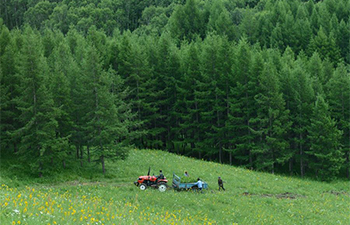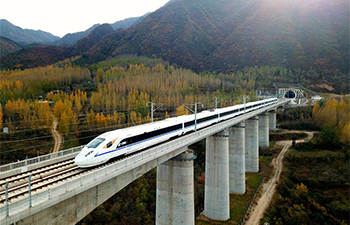A bullet train prepares to leave for Xi'an, capital of northwest China's Shaanxi Province, at the Chongqingbei Railway Station in southwest China's Chongqing Municipality, Dec. 6, 2017. High-speed trains linking Xi'an and Chongqing, began operation on Wednesday, slashing the travel time between the two cities from 9.5 hours to just 5.5. The new route includes a new section of the high-speed rail line linking Xi'an with Chengdu, capital of southwest China's Sichuan Province, which also started operation on Wednesday. (Xinhua/Tang Yi)
XI'AN, Dec. 6 (Xinhua) -- A new high-speed rail line went into operation in western China Wednesday, linking Xi'an with Chengdu.
The 658-km line is China's first rail route running through the Qinling Mountains, which are a natural boundary between north and south China. The Qinling Mountains are famous for its steep terrain and risky roads.
The high-speed train left Xi'an, capital of northwest China's Shaanxi Province, for Chengdu, capital of Sichuan Province at 8:22 a.m.
The window of the train displayed a poem from ancient Chinese poet Li Bai: "Walking from Shaanxi to Sichuan is harder than climbing up to the sky." The train company put panda dolls on the seats as gift for the travelers.
"It was great luck to get a ticket," said Zhang Wenke, a Xi'an-based company employee."
The train tickets were sold out within five minutes, according to reports.
For Zhang, the new journey was a ride on a love-train, as girlfriend studies in Chengdu. For the past two years, he has often traveled more than 16 hours on slower trains to meet her.
With a top speed of 250 kph, the rail service will slash the travel time between the two cities to four hours and seven minutes. By the end of the year, this will be further shortened to three hours and 27 minutes.
"Thanks to the high-speed train service, we can visit each other every week now," Zhang said.
Building of the high-speed rail line in began in 2012, and builders had to overcome many difficulties as the line goes through one of China's most mountainous areas.
The new line features many tunnels and bridges, and includes a 16-km tunnel with double tracks, one of Asia's longest.
The new line is a part of China's national high-speed rail network, which was 22,000 kilometers-long as of the end of last year.
China is aiming to add another 10,000 km by 2020 and surpass 45,000 km by 2030. Currently, about one-third of the country's high-speed railways can run at speeds of 350 kph.
The new high-speed rail line will also boost industrial cooperation among cities in western China, such as Xi'an, Chengdu and Chongqing.
Before the Xi'an-Chengdu High-speed Railway opened, a high-speed railway linking the city of Baoji in Shaanxi, with Lanzhou the capital of neighboring Gansu Province, began operation on July 9.
Poor transport infrastructure has caused China's west to lag behind eastern regions in terms of economic competitiveness. Building more roads, railways and airports has become a necessity for the country's western region to propel growth and social development.
But the new rail line has caused environmental concerns. As it cuts through the ecologically important Qinling Mountains, home to many endangered species, including giant pandas, golden monkeys and crested ibis, reducing the impact on wildlife along the line has been a key challenge.
A research team consisting of wildlife protection experts was authorized to map out a feasible environmental plan for the railway.
"This is why builders created so many bridges and tunnels. It increased the building cost but greatly reduced the impact on the habitat of wildlife," said Wu Xiaomin, 55, one of the wildlife experts.
For Wu's team, the biggest problem was how to protect the crested ibis, which usually fly 15 meters above the ground and may hit trains running on the bridge.
They installed a special net to protect the birds along a 33 km section of the line in Yangxian County in Shaanxi, a major bird habitat.
















